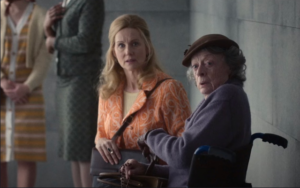THE MIRACLE CLUB: 2 ½ STARS. “evocative sense of time and place.”
 Despite the title, “The Miracle Club” isn’t so much about miracles as it is redemption, faith and uplift.
Despite the title, “The Miracle Club” isn’t so much about miracles as it is redemption, faith and uplift.
Set in 1967, in Ballygar, Ireland, this is the story of four women. Chrissie (Laura Linney) left the seaside town for Boston under a cloud forty years before and hasn’t been back. When she returns for her mother’s funeral, she must face the demons of the past, and the people she left behind, including her former BFF Eileen (Kathy Bates) and her late mother’s passive-aggressive best friend Lily (Maggie Smith). Bitterness runs deep between the three, each harboring grudges that have bubbled for four decades.
At a church fundraiser, Father Dermot Byrne (Mark O’Halloran) the local priest and center of religious life in the small town, throws a talent show. The prize is a trip to Lourdes in southwest France. One of the most visited places by Catholics from around the world, it is a pilgrimage site where, since 1858, the faithful have flocked to pray for miracles while bathing in the healing waters where a young girl named Bernadette Soubirous is said to have witnessed visions of the Virgin Mary.
Despite their best efforts at the talent show, Eileen, Lily and new mom Dolly (Agnes O’Casey) come in second, winning a hunk of meat instead of the coveted tickets. The first-place winner, feeling sorry for them, offers his tickets to them, and soon they are boarding the bus for Lourdes. Along for the ride is Chrissie, who uses her mother’s ticket for the trip.
On site in the holy town, miracles are in short supply but the situation forces the three generations of women to confront their pasts and prejudices. “You don’t come to Lourdes for a miracle,” says Father Byrne. “You come for the strength to go on when there is no miracle.”
“The Miracle Club” isn’t about divine agency. Nothing miraculous happens, excepting the power of truth and compassion to heal the long-simmering wounds each of these women carry. Their shared trauma (NO SPOILERS HERE) overwhelms their lives, forming who they are as people. The actors imprint each of these characters with the cumulative weight of their lives, willing Eileen, Lily and Chrissie into stubborn life, despite a script that attempts to keep them as stereotypes.
It is these performances that give “The Miracle Club” much of its power to engage with the audience. It is in each of their abilities to imply the inner lives of the characters without necessarily verbalizing them, that shows how deeply they have been devastated by past events. That, and the movie’s evocative sense of time and place, create the backdrop for the more pedestrian story in the foreground.
